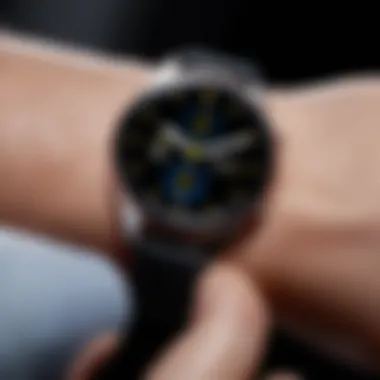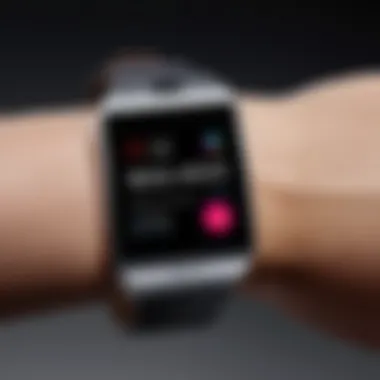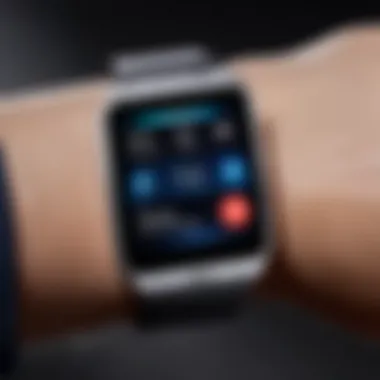Choosing the Best Samsung Smart Watch: A Detailed Review


Intro
The world of technology revolves around convenience and innovation, and smart watches are at the forefront of this transformative wave. Samsung smart watches, in particular, merge style with functionality, appealing to a diverse array of users ranging from fitness enthusiasts to tech-savvy professionals. This analysis intricately unpacks the offerings of Samsung's flagship devices, shedding light on their specifications, performance, and user experience. For anyone on the fence about investing in a Samsung smart watch, the insights gathered here will serve as a crucial resource for making an informed decision.
Product Overview
Samsung has established itself as a major player in the smart watch game, with its latest models boasting impressive features and aesthetic designs. Owning one goes beyond just timekeeping; these devices are extensions of our smartphones, bridging the gap between connectivity and wearability.
Specifications
When evaluating a Samsung smart watch, key specifications often include:
- Display: AMOLED technology for vibrant colors and deep contrasts.
- Processor: An efficient chipset that ensures smooth operation.
- Storage: Space for music and apps, essential for personalization.
Design
The design of these watches is nothing short of striking. From the upscale Galaxy Watch series to the more sporty Galaxy Fit, there's a style to suit everyone. Materials like stainless steel and Gorilla Glass 5 provide durability without compromising on elegance. Each watch feels well crafted, embodying a modern aesthetic that complements various lifestyles.
Features
Samsung smart watches come packed with a variety of features, including:
- Health Monitoring: Heart rate tracking, sleep analysis, and stress management built right in.
- Notifications: Seamless syncing with your smartphone to keep you updated on messages and calls.
- Apps: Access to a myriad of apps, enhancing functionality considerably.
Pricing
Pricing varies depending on the model and features. For example, while the Galaxy Watch Active 2 offers a budget-friendly experience, the Galaxy Watch 5 Pro caters to those looking for top-tier functionality, at a price to match. Consumers should weigh their needs against their budgets for optimal satisfaction.
Performance and User Experience
A smart watch can only be called "smart" if it performs reliably and efficiently. Here, we assess important performance indicators that would shape a user's experience with Samsung watches.
Speed
Users expect quick responses from their devices, and Samsung watches deliver just that. Navigating through apps is generally smooth, thanks to the optimized software and powerful processors at play.
Battery Life
Battery longevity is a game-changer in the world of wearable tech. Depending on usage, most Samsung watches can last up to 40 hours, with options for low-power modes to stretch battery life even further.
User Interface
The user interface is responsive, making it easy to transition between apps and notifications. The interface feels intuitive, designed to ensure a user-friendly experience, even for those new to smart watches.
Customization Options
One of the standout features is customization. Users can choose watch faces ranging from analog to digital, changeable depending on mood or occasion. This level of personalization enhances the overall experience, allowing wearers to truly make the watch their own.
Comparison with Similar Products
Samsung's smart watches contend with various alternatives on the market. Comparing them with other top brands can help potential buyers evaluate their choices better.
Key Differences
Unlike many competitors, Samsung watches integrate well with Android smartphones, making them a favorite among Android users. The versatility in health features often sets them apart from similarly priced alternatives that may focus on fewer functionalities.
Value for Money
In terms of value for money, the breadth of features offered by Samsung watches often outweighs their costs. While certain brands shine in fitness tracking, Samsung manages to balance health, functionality, and style, making it a worthy investment.
Expert Recommendations
Understanding when and how to use these devices can enhance the experience significantly.
Best Use Cases
For fitness tracking, models like the Galaxy Watch Active 2 excel. On the flip side, professionals seeking a smartwatch for notifications, calendar management, and health tracking should look towards the Galaxy Watch 5.
Target Audience
Samsung smart watches cater to different segments, including fitness fanatics, business professionals, and casual users seeking connectivity.
Final Verdict
Understanding Smart Watches: An Overview
In the fast-paced world of technology, smart watches have carved a niche that seamlessly blends functionality and style. Their importance cannot be overstated, especially in the context of Samsung smart watches, which continue to reshape how we approach health, communication, and time management. This section aims to provide a foundation for understanding smart watches and their relevance in the current tech landscape.
As we dive deep into this article, it becomes paramount to grasp the basic definition and evolution of smart watches in order to appreciate their sophistication. This understanding becomes the springboard for evaluating the particular features and benefits offered by Samsung devices, setting the stage for richer discussions ahead.
The Definition of Smart Watches
Smart watches can be defined as wearable technology designed to perform various tasks that stretch beyond telling time. They can connect to smartphones, providing users with notifications, health monitoring, navigation, and much more.
At their core, smart watches act as a companion to your smartphone, enhancing convenience and allowing for a hands-free experience. Most modern smart watches make use of touchscreen interfaces, integrating various apps that cater to both personal and professional needs. Here are some key elements that distinguish smart watches from traditional watches:
- Connectivity: They often rely on Bluetooth or Wi-Fi capabilities to sync with smartphones.
- Sensor Integration: From heart rate monitors to GPS, smart watches come equipped with a wide array of sensors to track various metrics and keep health at the forefront.
- Customization: Users can tailor watch faces and download apps based on personal preferences, making each device unique to its owner.
Evolution of Smart Watches
The journey of smart watches is quite fascinating, from simplistic digital displays to the advanced, multifunctional devices we see today. Early iterations were primarily focused on fitness tracking, with basic features to monitor steps and calories burned.


Here is a brief look at their evolution over the years:
- Early Models (2000s): Devices like the Fossil Palm and Microsoft SmartWatch primarily served as PDAs on the wrist.
- Introduction of Smart Features (2010s): With the unveiling of devices like the Pebble, the concept of syncing with smartphones gained traction, allowing for notifications and apps.
- Samsung's Entry (2013): Samsung's Galaxy Gear was among the first to incorporate full smartphone functionality, paving the path for its subsequent models.
- Current Landscape (2020s): Today, smart watches not only track health metrics but also support mobile payments, voice assistants, and extensive notifications, making them indispensable tools in our daily lives.
Understanding the evolution of smart watches helps one appreciate how far they've come and the technology that makes them tick. The advances in design, usability, and health integration deliver a compelling case for consumers, particularly those who are already invested in the Samsung ecosystem.
"The smart watch is not just a tool; it has evolved into a lifestyle accessory that enhances both personal and professional domains."
As we proceed with this analysis, recognizing the trajectory of smart watches will pave the way for a more nuanced conversation about Samsung's offerings, specific models, and their distinctive advantages.
Why Choose Samsung
When it comes to selecting a smart watch, many may wonder why Samsung often stands out from the crowd. This is a significant topic to explore, particularly because Samsung's offerings blend advanced technology with user-centric design. Smart watches are no longer just accessories; they have become vital tools for managing health, communication, and lifestyle. Therefore, choosing the right brand can influence your overall user experience.
Brand Reputation and Innovation
Samsung has forged a reputable name in the tech landscape over the decades. The company's journey from a mere manufacturer of electronic goods to a leader in smart technology illustrates its commitment to innovation. This conglomerate consistently pushes the envelope, releasing cutting-edge products that catch the attention of consumers and critics alike.
Consider the Galaxy Watch series; it showcases not only smart features but also an aesthetically pleasing design that appeals to a wide audience. With each new release, Samsung incorporates feedback from users, ensuring enhancements that resonate with lifestyle needs.
Another standout aspect is how Samsung occasionally takes risks with features. For example, the inclusion of rotating bezels offers an intuitive user interface different from the usual touch screens. This kind of creativity is not merely about differentiation; it also reflects the company's philosophy of making technology accessible and enjoyable.
Integration with Android Ecosystem
In an age where devices should seamlessly work together, Samsung's smart watches exhibit remarkable compatibility, particularly with Android devices. For Android users, this integration means they can easily sync their watches to smartphones, accessing notifications, calls, and apps with just a flick of the wrist. The S Health app exemplifies this; it allows users to monitor fitness goals and health stats right from their wrist while integrating with Samsung phones to provide detailed analyses.
Moreover, Samsung’s collaboration with other third-party applications significantly enhances functionality. Fitness apps, productivity tools, and communication platforms often have tailored experiences that sync effortlessly with Samsung’s devices. This creates an ecosystem that feels complete, unlike some of its competitors who may leave gaps in functionality.
Additionally, the user experience is made simpler with the ability to switch from one Samsung device to another without missing a beat. Whether you’re answering a call or getting alerts from your email, the continuity of experience is commendable.
In essence, choosing Samsung isn’t just about picking a smart watch; it’s about entering a world where your devices communicate smoothly, enhancing both enjoyment and productivity in day-to-day tasks.
"In today's fast-paced world, it's more than just a watch; it's a holistic approach to managing our lives effectively."
This combination of established brand reputation, innovative designs, and seamless integration with the Android ecosystem makes Samsung a compelling choice for anyone in the market for a smart watch. Expect not only to wear a device but rather to experience a significant augmentation of your everyday activities.
Key Features of Samsung Smart Watches
In the world of wearable technology, Samsung smart watches stand out due to a plethora of distinctive features that cater to users’ varying needs. Each key feature is instrumental in creating a versatile user experience that transcends mere timekeeping. From health metrics to customizable aesthetics, these watches aim to provide a comprehensive solution for tech-savvy individuals, especially those entrenched in the Android ecosystem. The following attributes not only enhance functionality but also demonstrate why Samsung remains a top contender in this space.
Health and Fitness Tracking
When it comes to health and fitness, Samsung smart watches prove to be valuable companions. They come packed with a range of tracking capabilities, empowering users to stay on top of their wellness goals.
Heart Rate Monitoring
One of the standout aspects of heart rate monitoring in Samsung smart watches is its accuracy and real-time data feedback. This feature allows users to track their heart rate throughout the day or during workouts, which can be pivotal for those trying to optimize their exercise regimens or keep health concerns at bay.
The key characteristic here is the precision with which Samsung measures heart rates, using advanced sensors that ensure data reliability. When individuals see their heart rate fluctuate during a strenuous workout, it's a reminder that they need to manage their effort levels. This feature is popular among fitness enthusiasts for its noticeable impact on workout efficiency and overall health awareness.
- Advantages: Real-time stats, accuracy, and proactive health monitoring.
- Disadvantages: Accuracy may decrease during high-intensity movements.
Sleep Tracking
Another valuable element is sleep tracking, which allows users to get insights into their sleeping patterns. Observing the quality and duration of your sleep can lead to better sleep hygiene practices.
The key characteristic of sleep tracking is its comprehensive understanding of sleep phases – deep sleep, light sleep, and REM sleep. This deep dive into one’s sleep cycle can help users assess their routines and make adjustments as needed. Many users find this enlightening, as they parallel their lifestyle with improvements in sleep quality.
- Advantages: Personalized sleep insights, recommendations for improvement.
- Disadvantages: The need for consistent wear to gather accurate long-term data.
Activity Tracking
Activity tracking completes the holistic approach to health monitoring. It automatically registers various workouts, making it easier to keep tabs on your daily performance.
The key characteristic of activity tracking lies in its recognition of different activities. The watch can identify whether you’re running, cycling, or engaging in yoga, providing tailored metrics for each type. This adaptability makes it a beneficial choice for individuals with diverse fitness interests, promoting a lifestyle that encourages regular movement.
- Advantages: Versatility, automatic detection of activities.
- Disadvantages: May occasionally misidentify less common exercises.
Customization and Personalization
Customization is another pillar that enhances user satisfaction. Samsung’s offering allows users to express their personality through their smart watches.
Watch Faces
The availability of diverse watch faces enables users to select styles that resonate with their mood and environment at any given moment. This key characteristic makes it not just a gadget, but also a statement piece. Users can opt for minimalist designs on busy days or vibrant displays for special occasions.
- Advantages: Wide variety promotes personalization.
- Disadvantages: Options can overwhelm new users seeking simplicity.
Accurate Notifications
Accurate notifications play an essential role in ensuring that users can stay connected without being tethered to their smartphones. By intuitively syncing with their phones, Samsung watches effectively filter which notifications are essential.
This key characteristic allows for seamless multitasking and real-time communication, improving productivity. Users can prioritize their focus without missing out on crucial updates.
- Advantages: Efficient communication, reduces phone dependency.
- Disadvantages: Some notifications may be missed if settings aren’t optimized well.
Interchangeable Bands
The option to change bands is a practical feature that adds a layer of adaptability. Users can switch bands for various occasions or outfit choices.
This key characteristic emphasizes practicality without sacrificing aesthetic appeal, making it easy to transition from workouts to more formal settings. Different materials and colors can completely change the overall look of the watch.
- Advantages: Enhances versatility, easy to match to outfits.
- Disadvantages: Quality of bands may vary with third-party options.


Battery Life and Performance
Lastly, battery life and performance are critical when considering any smart device. Samsung’s commitment to delivering a robust battery ensures their watches can keep up with an active lifestyle. The durability of the battery translates to longevity between charges, letting users engage extensively with all features without the constant worry of depletion.
In summary, the key features of Samsung smart watches collectively create a rich user experience that goes beyond just tracking time. These functionalities not only cater to individual preferences but also optimize everyday tasks, making these devices become essential tools in managing and enhancing one’s lifestyle.
Exploring Popular Models
When it comes to purchasing a Samsung smart watch, it's crucial to dive into the popular models available. Exploring these models not only highlights the unique offerings from Samsung, but it also helps potential buyers narrow down the choices based on their preferences and needs. As technology continues to evolve, staying updated on the latest smart watch models becomes ever more important.
The smart watch market is flooded with options, yet the models from Samsung often stand out for their reliability and features. By examining the prominent choices, consumers can assess aspects like design, functionality, and user experience. This analysis can lead to better decision-making, ensuring consumers pick a watch that aligns with their lifestyle.
Samsung Galaxy Watch Series
Comparison of Different Models
The Samsung Galaxy Watch Series presents a variety of models to suit various needs, making a detailed comparison essential for interested buyers. Each model within the series holds its own distinctiveness, catering to different user preferences and use cases. For instance, some models may focus on fitness and health tracking, while others may prioritize aesthetics or battery life.
One key characteristic of this comparison is the consistent design language across the series. Whether you choose the Galaxy Watch 5 or the older Galaxy Watch Active 2, the seamless integration of style and functionality is notable. Each device typically features durable materials and vibrant displays, making them not just tech accessories but also fashion statements.
A unique feature in this comparison is the rotating bezel available on some versions of the Galaxy Watch. This feature aids in navigation and enhances user experience, making it a beneficial choice for those who like intuitive interfaces. However, one downside of this system could be its tendency to wear over time, depending on usage.
Strengths and Weaknesses
When analyzing the strengths and weaknesses within the Samsung Galaxy Watch Series, a critical aspect to consider is their comprehensive health tracking capabilities. The Galaxy Watch models offer a plethora of sensors designed to monitor heart rate, blood oxygen levels, and stress levels. This makes these devices particularly useful for health-conscious individuals.
On the other hand, the battery life can be a mixed bag; while some users enjoy long-lasting power, others may find themselves needing a midday charge with heavier usage. This inconsistency makes it important for potential buyers to map out their daily routines and assess how these watches fit in.
Samsung Galaxy Fit Series
Target Audience
The Samsung Galaxy Fit Series caters primarily to those who prioritize fitness without the overwhelming features of more advanced models. This line of devices is particularly well-suited for casual fitness enthusiasts, individuals looking for basic health tracking, and those seeking a stylish yet unobtrusive wearable.
A significant aspect of this target audience is their inclination toward simplicity. The Galaxy Fit models focus on essential fitness metrics, offering a clean interface that keeps users engaged without overloading them with unnecessary information. This can be appealing for users who might find the extensive features of the Galaxy Watch series daunting.
Useful Features
Within the Galaxy Fit Series, the useful features are primarily centered around maintaining a healthy lifestyle. The heart rate sensor, sleep tracking, and guided breathing exercises are all included without overwhelming complexity. This simplicity is, in many ways, this series' greatest strength.
However, while the basic functionality serves its purpose for everyday tasks, some may find the lack of advanced features a disadvantage. Users expecting comprehensive smartphone integration and app compatibility may feel limited by the fit models. Making an informed choice between advanced and more minimalist devices is vital when selecting the appropriate model.
"Having choices is great, but understanding those choices is even better."
User Experience and Interface
When evaluating a smart watch, the User Experience (UX) and interface design play a pivotal role. A well-crafted user interface bridges the technology with the user, turning complex functionalities into intuitive experiences. Samsung smart watches are particularly known for balancing functionality with aesthetic appeal, ensuring that users not only find them helpful but also enjoyable to use.
Operating System and Usability
At the heart of a Samsung smart watch lies its operating system, which significantly affects the usability. Most Samsung smart watches run on Wear OS, a platform optimized for smart wearable devices. This system is user-friendly, with a clean layout that allows navigation through tiles, apps, and notifications with ease. Users appreciate features like quick settings and customizable watch faces, providing both practicality and style.
The responsiveness of the touchscreen is another consideration. The high-resolution display shows clear graphics and text, and the haptic feedback enhances the user’s interaction. This tactile response can make or break the experience. A well-executed interface ensures that navigating through various options feels seamless, minimizing frustrations often found in poorly designed tech.
To illustrate, many users find the Samsung Galaxy Watch 4 particularly intuitive, with its rotating bezel offering a mechanical way to scroll through menus, which can feel more satisfying than swipe gestures.
Third-Party App Compatibility
The compatibility with third-party applications is a game-changer for many users. Smart watches today function as mini smartphones, and the ability to install various apps can greatly enhance their utility. Samsung's integration with the Google Play Store means there’s a rich library of applications available, covering everything from fitness to productivity.
However, it's not just about the quantity of apps available but also their quality and performance. Some of the highest-rated apps for Samsung watches include fitness trackers, navigation tools, and convenience apps that allow you to control your smart home devices directly from your wrist. Features like Spotify, Strava, and various meditation applications add layers of functionality that appeal to tech-savvy users.
Yet, it is noteworthy that not all apps are created equal. Users often report mixed experiences with app performance. Some apps may function well, while others might glitch or drain battery life unexpectedly. Addressing these quirks can be a hit-or-miss experience depending on the developer’s updates and the watch’s ability to support them efficiently.
In summary, the user experience and interface significantly affect how users interact with Samsung smart watches. From the operating system’s robust usability to the wide array of compatible applications, these elements come together to create a comprehensive package that can meet the needs of diverse users.
Compatibility with Smartphones
In the world of smart watches, compatibility with smartphones is a critical aspect to consider. It’s not just about having a sleek design or impressive features; if a smart watch doesn’t work seamlessly with your phone, it can be more of a headache than a help. For many users, the convenience of receiving messages, calls, and notifications right on their wrist hinges on how well their watch interacts with their smartphone.
When we talk about Samsung smart watches, their compatibility generally revolves around two key types of devices: Samsung Galaxy devices and non-Samsung Android devices. By understanding how each type interacts with the smart watch, users can make better-informed decisions based on their existing tech ecosystem.
Samsung Galaxy Devices
Samsung Galaxy devices provide an unmatched synergy with Samsung smart watches. This compatibility transcends mere connection; it offers a cohesive experience that leverages both hardware and software advantages.
- Seamless Integration: Features like notifications and health tracking sync flawlessly. Users are often impressed by how information flows effortlessly from their phones to their watches. This is particularly evident in apps such as Samsung Health, which allows users to track their wellness data in real time.
- Ecosystem Benefits: Owners of Samsung Galaxy devices will find that their smart watch can control various aspects of their mobile experience. For example, adjusting music playback, answering calls, and even managing smart home devices become simple tasks.
- Updates and Features: With Galaxy smartphones, updates to software can be expected in tandem with watch updates. This means users are consistently getting access to the latest features and improvements.
In summary, for users of Samsung Galaxy devices, owning a Samsung smart watch can feel like an extension of their phone rather than a separate gadget.
Non-Samsung Android Devices
While Samsung offers robust compatibility with its Galaxy line, the scenario changes when considering non-Samsung Android devices. The experience can still be favorable but presents a few more variables.
- Limited Features: Not all features available to Samsung Galaxy users will translate to other Android devices. For instance, certain app integrations might be restricted, which might limit functionality.
- Connectivity Issues: Some users have reported connectivity hiccups or slower synchronization rates. This can lead to frustration, especially if users expect a fluid experience akin to what they would find with Samsung phones.
- User Management: The process of managing notifications or app settings may require extra steps. Users have to ensure proper configurations, and at times, that can be a laborious task.
To put it simply, while Samsung smart watches work with non-Samsung Android devices, the fit may not be as tailor-made as it is with their own Galaxy line.
"Compatibility is not just about whether devices connect, it's about how well they work together to enhance user experience."
Ultimately, when selecting a Samsung smart watch, considering the type of smartphone you have is vital. From enjoying complete functionality with a Galaxy phone to navigating limitations with non-Samsung Android devices, knowing what to expect can make all the difference.


Pricing and Value Assessment
When it comes to choosing a Samsung smart watch, pricing and value assessment play a crucial role in guiding consumer decisions. Understanding what you’re getting for your buck can spell the difference between a purchase that enhances your tech arsenal and one that leaves you second-guessing. This section will get into the nitty-gritty of how to evaluate prices in relation to features, performance, and overall use cases of the devices.
In the bustling market of smart watches, squaring off competitors against each other helps users understand which models offer more bang for their buck. Samsung smart watches typically fall within a broad range of prices, catering to both budget-conscious customers and those who don’t mind splurging a little for premium features.
The key here is not just about finding the cheapest option, but rather about balancing cost with the features and performance that suit individual needs. When considering pricing, it’s wise to factor in the primary use you have in mind for the device, be it health tracking, notifications, or smart features. Also, remember that while some smart watches boast a reduced upfront price, they might skimp on long-term value through battery issues or lack of software updates.
Budget Models
Samsung does a commendable job of offering budget models that don’t skimp on functionality. The Galaxy Fit line is a perfect example. These watches shine when it comes to essential health tracking features like sleep monitoring and heart rate tracking, and they come at a price point that’s hard to beat.
Specifically, the Galaxy Fit 2 offers a great starting point for those new to the smart watch experience. Here’s what you might like:
- Affordability: Generally priced under $100, making it accessible for many.
- User-Friendly Interface: A simple setup makes it a breeze for first-timers.
- Essential Features: Includes like step counting, sleep duration, and heart rate monitoring, providing value without overwhelming.
Even as a budget option, the trade-offs aren’t as glaring as you might expect. While you may not get the bells and whistles of higher-end models, the Galaxy Fit 2 still holds its own and provides solid performance for daily uses.
Premium Options
On the flip side of the spectrum, Samsung’s high-end offerings—like the Galaxy Watch series—bring a multitude of advanced features packed into sleek designs. These watches position themselves not just as timekeepers but as comprehensive health and smart device companions.
For discerning consumers willing to invest more, here are some considerations:
- Feature-Rich: High-end models provide extensive well-being tools like ECG monitoring, advanced workout tracking, and even stress management analytics.
- Enhanced Display and Build Quality: With vibrant AMOLED displays and durable materials, these watches tend to outshine budget counterparts in both aesthetics and robustness.
- Customizability: The higher-end models allow a greater degree of personalization, from watch faces to interchangeable bands.
For instance, the Samsung Galaxy Watch 4 offers health insights and smart features that integrate seamlessly with other Galaxy devices. While the price exceeds the $250 mark, the extensive capabilities and aesthetics appeal to both tech enthusiasts and style-conscious users.
In sum, when weighing budget models against premium options, think about your own needs. If you're looking simply for fitness tracking on a shoestring budget, a basic model might suffice. However, if your goal includes sophisticated health features and seamless integration with smart home devices, a premium model like the Galaxy Watch 4 is worth considering.
In the end, researching specific models and understanding their features in the context of your lifestyle is key to determining the best fit, both in terms of budget and value.
Common Considerations Before Purchase
Before you whip out your wallet and dive headfirst into the sea of Samsung smart watches, it’s imperative to take a step back and thoroughly assess what you really want. Getting a smart watch isn't merely about grabbing the latest gizmo. It’s about finding a device that aligns with your lifestyle, complements your daily activities, and fits snugly on your wrist—figuratively and literally. This section aims to shed light on critical elements to consider before making any decisions about a Samsung smart watch. Challenge yourself to reflect on these aspects to make a thoughtful purchase.
Assessing Personal Needs
Wading through the myriad of options available can feel like trying to find a needle in a haystack. But in reality, the first question you should ask yourself is: What do I need a smart watch for? Are you an athletic type looking to track your workouts, or maybe a busy professional needing timely notifications on the go? Or perhaps you simply want to keep an eye on your health metrics? Evaluating your personal needs is essential.
Think about your daily routine. If your day involves lots of moving around, you'll want a model with robust fitness tracking features, such as the Samsung Galaxy Watch Active, which excels in this area. On the other hand, if you are keen on receiving calls or messages while multitasking at your job, then you might prioritize battery life and notification efficiency. Here are some elements to consider:
- Optimal Health Tracking: Look for heart rate monitoring, stress management, and sleep analytics if you prioritize health.
- Durability and Build Quality: If you're outdoorsy, it’s vital to check the watch's resistance to water and bumps.
- User Interface: A more intuitive interface can make a world of difference in daily usability.
Understanding Limitations
It’s tempting to get engrossed in all the fabulous features, but no device is without its limitations. Understanding these restrictions can help manage your expectations and prevent buyer’s remorse later on.
For instance, while Samsung smart watches offer excellent functionality, they aren't all perfect for every smartphone. If you're not sporting a Samsung Galaxy device, you may experience some compatibility issues that can hinder the full use of specific features. Furthermore, the battery life, although relatively decent, varies significantly depending on how much you push the device. Here’s a shortlist of things to keep an eye on:
- Compatibility Issues: Ensure your existing phone supports the watch's features fully.
- Battery Limitations: Heavy users might find themselves charging the device more frequently than desirable.
- App Availability: Some apps might not be as polished or feature-rich as their smartphone counterparts.
"A well-considered purchase isn’t just about features; it’s knowing how a tool complements your unique lifestyle."
Future Trends in Smart Watches
In a world where technology evolves faster than a fox can run, staying updated on the future trends in smart watches is vital. As we delve into this topic, it becomes apparent that these trends are not just fads; they represent the direction in which wearable technology is heading. Being aware of such trends helps consumers not only make informed purchases but also embrace the capabilities their gadgets can offer.
The significance of understanding future trends lies in their ability to influence consumer behaviors and expectations. Smart watches have transitioned from being mere fitness trackers to multifunctional devices integral to everyday life. Therefore, knowing what awaits on the horizon can help users select a device that aligns with their aspirations and requirements.
Emerging Technologies
Emerging technologies are paving the path for the next generation of smart watches. One of the most significant advancements is in health monitoring features.
- Biometric Sensors: Today’s wearables like the Samsung Galaxy Watch are already equipped with heart rate monitors. However, future models are expected to integrate advanced biometric sensors, such as glucose monitors or blood pressure tracking. This leap will provide users with more accurate health data, vital for personal health management.
- Battery Technology: Another area of rapid advancement is battery technology. Solid-state batteries and solar energy integration may lead to significantly longer-lasting devices. Consumers would gain convenience from devices that require less frequent charging.
- AI and Machine Learning: The integration of AI will likely enhance the personalization of smart watches. For instance, watches that can learn user habits can send adaptive notifications, such as reminders for exercise or meditation, based on the individual’s lifestyle patterns.
As emerging technologies take root, consumers will see a marked improvement in the functionality and user experience of smart watches.
Integration with IoT Devices
As home automation continues to rise, the integration of smart watches with Internet of Things (IoT) devices is becoming increasingly important. This connectivity means smart watches can serve as control hubs for various connected devices in one’s environment.
Consider the following points regarding IoT integration:
- Smart Home Control: Imagine controlling your lights, thermostat, and security system through a simple tap on your watch. This feature is not just a dream of the future; it is fast becoming a reality. Users using Samsung devices will benefit from seamless integration with Samsung SmartThings, making home management more efficient.
- Enhanced Communication: Integration with IoT means users can receive instant notifications or alerts on their watches related to home security or appliance status. This instant connectivity enhances communication efficiency, allowing users to respond promptly to any events needing attention.
- Data Synchronization: Smart watches will likely synchronize with various devices, collecting data that can analyze user habits and routines. This offers rich insights into health and efficiency, helping individuals make informed decisions about their lifestyle.
*"The strides in IoT integration mean that your watch doesn’t just tell time; it could soon become a central command for your entire digital life."*
Finale and Recommendations
When it comes to evaluating Samsung smart watches, wrapping up with a comprehensive conclusion is crucial. This section highlights the importance of considering individual lifestyles and usage patterns when selecting a device. Samsung offers a range of watches that cater to various preferences, from fitness enthusiasts to tech-lovers who desire stylish sophistication. A careful examination of features such as battery life, health tracking capabilities, and compatibility ensures an informed purchase decision.
Ultimately, investing in a smart watch is about enhancing everyday life. It's not merely about the tech specs, but how these devices can fit seamlessly into your daily routine, providing you with convenience and functionality.
Final Thoughts on Samsung Smart Watches
Samsung smart watches present a well-rounded option for consumers in the wearable tech market. With various models available, each device serves its purpose—whether that means tracking health metrics or handling calls on the go. The design is sleek and often customizable, ensuring that wearers can express their personality while staying connected.
Consumers should weigh their specific needs, as some models shine in fitness tracking while others focus more on smart features or battery longevity. Regardless, Samsung’s commitment to innovation hghlights a strong future in smart technology. Those who remain within the Android ecosystem reap further benefits through enhanced compatibility and integrated features.
"Choosing a smart watch is largely about matching the device to your personal and professional lifestyle."
Best Model for Specific Needs
Selecting the best Samsung smart watch hinges on aligning features with individual needs. Here are a few recommendations:
- Samsung Galaxy Watch 6: Ideal for fitness aficionados. Its comprehensive health monitoring features and robust activity tracking make it perfect for those who enjoy working out.
- Samsung Galaxy Watch Active2: This one stands out for its user-friendly interface and sleek design, appealing to consumers looking for a classic watch feel without sacrificing smart functionality.
- Samsung Galaxy Fit 2: Designed for those who just want the basics—health tracking without the bells and whistles. This model offers simplicity and straightforward fitness tracking, making it an excellent choice for budget-conscious users.
Each model has its strengths and weaknesses, but consumers can navigate these choices by determining what aspects of functionality matter most in their day-to-day lives. Investing in a Samsung smart watch not only boosts tech-savviness but also enhances personal wellbeing and connectivity in today's fast-paced world.







